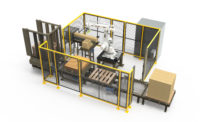How cobots make automation accessible to small and medium sized manufacturers


Manual packaging and palletizing are repetitive, unergonomic tasks and a recurring source of workplace injuries. According to the Bureau of Labor Statistics, the number one cause of occupational injuries involving days away from work was overexertion caused by excessive physical effort and repetitive motion, accounting for 31% of all lost days.
Ergonomics is only an issue if you can find workers, of course. Companies of all sizes and across all sectors, including secondary food processing, are facing challenges in finding and retaining manufacturing labor. This combination of challenges makes end-of-line tasks such as packaging and palletizing ideal candidates for automation.
At this point, the automation options for small and medium-sized companies (SMEs) are radically different than those of larger companies. The SME segment has historically been under-served by traditional automation due primarily to the cost, complexity, and size of traditional industrial robots.
Traditional industrial robots and palletizing systems require large capital outlays, are costly to maintain, and come with a large footprint made even larger by the need for extensive fencing and guarding systems. In addition, while traditional industrial automation excels at performing low mix/high volume (LMHV) tasks, the complexity of these systems can make them a poor fit for high mix/low volume (HMLV) operations due to the amount of downtime required to reprogram these systems.
Large companies are more likely to have the floor space required to accommodate traditional industrial robots. In addition, large companies can handle the cost of hiring robot programmers to deploy and maintain these systems, or they will have full-time robotics engineers and technicians in-house.
SMEs don’t have the same resources and have traditionally watched larger competitors enjoy the benefits of automated packaging and palletizing systems --improved consistency, enhanced throughput, and increased productivity. When traditional automation is the only game in town, big companies get bigger and SMEs struggle to survive.
Meet the cobots
The emergence of collaborative robots (or ‘cobots’) over the past decade has completely upended this traditional paradigm, empowering SMEs to enjoy the benefits of industrial automation for the first time.
The term ‘collaborative’ refers to the fact that following a safety risk assessment, cobots can be deployed side-by-side with skilled human operators without the need for extensive fencing and guarding systems.
Safe deployments alongside humans are possible because cobots can be configured with multiple safety protocols, including force and speed limitations, work envelope safe zones, and other safety limitations. From the end-user perspective, one of the main trade-offs to be considered when deciding between traditional robots and cobots relates to these speed and force limiting features. Traditional robots are faster and more powerful, but cobots are more affordable, easier to use, and safer.
In the past decade, companies of all sizes have deployed cobots on tens of thousands of applications, from material handling, box erecting, and case pack to quality inspection and palletizing.
Cobots make automation accessible to SMEs
The total installed cost of a cobot system is significantly less than traditional robot counterparts which means less capital outlay and a faster return on investment. Some companies provide leasing and Robots-As-A-Service opportunities that reduce the cost of implementing automation to an absolute minimum — music to the ears of cash-strapped SMEs.
Cobots are also, as a rule, much easier to program and deploy than traditional industrial robots. Instead of having to call a team of engineers out to reprogram your packaging and palletizing system, cobots can, after straightforward training, be programmed by end-users.
Instead of old-fashioned pendants running code only an engineer could understand, cobots can be programmed via attractive, easy-to-use pendants and simple, icon-driven programming interfaces. Some systems can even be programmed using intuitive smartphone applications.
There is, of course, variation among different cobot brands when it comes to usability. Those considering a cobot investment should look for companies that provide the type of easy-to-use programming interfaces and techniques listed above, in addition to the online training and education resources required to support quick and easy training and deployments.
Cobots also have a much smaller footprint than traditional industrial robots. Combined with their speed and force limiting safety features, this means that not only are cobots easy to move around a facility, but they can be deployed even in tightly packed packaging and palletizing stations where floor space is at an absolute premium.
Flexibility is another SME-friendly attribute of cobots. While traditional robots excel at LMHV tasks, cobots are ideally suited to HMLV operations. With cobots being so easy to transport and program, this means that cobots can easily and quickly be reassigned to new product runs and even to entirely new applications.
For more information, visit https://www.universal-robots.com/.
Looking for a reprint of this article?
From high-res PDFs to custom plaques, order your copy today!





